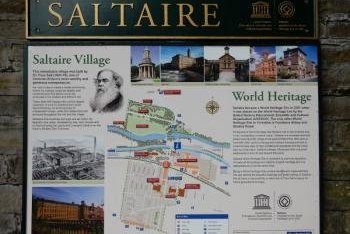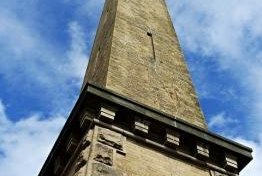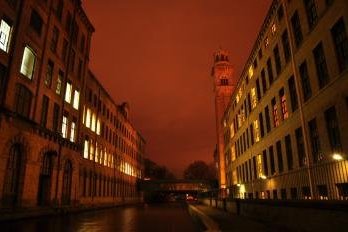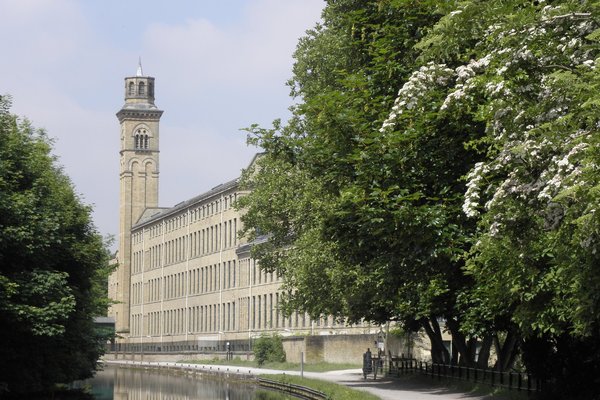United Kingdom
Saltaire
Saltaire is a Victorian-era model village that illustrates the philanthropic approach to industrial management typical of this period.
Saltaire was founded by Sir Titus Salt in 1853. He moved his entire business from Bradford to this site partly to provide better arrangements for his workers than could be had in Bradford and partly to site his large textile mill by a canal and a railway. His project is usually seen as an example of paternalism and it was influential on the international Garden City movement.
Community Perspective: The place still looks like a very nice place to live, though for a visitor, its industrial history isn’t well-explained and signage is poor. Frederik recommends visiting it at night.
Site Info
Official Information
- Full Name
- Saltaire (ID: 1028)
- Country
- United Kingdom
- Status
-
Inscribed 2001
Site history
History of Saltaire
- 2001: Inscribed
- Inscribed
- Type
- Cultural
- Criteria
- ii
- iv
Links
- UNESCO
- whc.unesco.org
- Official
-
- saltairevillage.info — Saltaire village website
- Related
-
- spartacus-educational.com — Titus Salt
- bbc.co.uk — Saltaire: A successful industrial township
All Links
UNESCO.org
- whc.unesco.org — whc.unesco.org/
Official Website
- saltairevillage.info — Saltaire village website
Related Resources
- spartacus-educational.com — Titus Salt
- bbc.co.uk — Saltaire: A successful industrial township
News Article
- May 26, 2025 bbc.com — Saltaire Secret tunnel once used by princess to be restored
- Nov. 11, 2023 thetelegraphandargus.co.uk — Innovative restoration work sees historic Saltaire church wins award
- Dec. 7, 2022 amp.theguardian.com — Plans for visitor centre in Saltaire draws residents’ ire
- Sept. 2, 2014 thetelegraphandargus.co.uk — Saltaire residents cry foul over 'incongruous' lamppost
- July 8, 2014 thetelegraphandargus.co.uk — Crack down on 'rogue' front doors in historic Saltaire
- June 14, 2014 thetelegraphandargus.co.uk — Trees in Saltaire to be chopped down in controversial move
- Dec. 24, 2013 thetelegraphandargus.co.uk — Saltaire launches £ 2m bid to make more of World Heritage Site
- Nov. 29, 2012 thetelegraphandargus.co.uk — Saltaire has only managed an estimated 0-3 per cent rise in tourism since 2001
- March 25, 2011 thetelegraphandargus.co.uk — Scrap metal thieves plunder Saltaire streets
- Feb. 20, 2010 thetelegraphandargus.co.uk — Saltaire to get tourist office at last
- May 18, 2008 thetelegraphandargus.co.uk — Pledge to re-build fire-hit Boathouse pub, built by Sir Titus Salt in 1871
- Feb. 10, 2008 thetelegraphandargus.co.uk — Plans for a £139 million bypass to run under Saltaire could jeopardise its World Heritage Site status.
- Sept. 23, 2006 thisisbradford.co.uk — Size matters when it comes to Saltaire signs!
Community Information
- Community Category
- Human activity: Urban planning
Travel Information
Recent Connections
-
Perfect Inscriptions
2001 -
Tunnels
"The route beneath Exhibition Road in S… -
Works by David Hockney
The original "Salts Mill" is on show at…
Connections of Saltaire
- Individual People
-
-
Works by David Hockney
The original "Salts Mill" is on show at the Hockney exhibition in the Mill.See cdn.shopify.com
-
- Trivia
-
-
Modelled after
New Mill: modelled on the campanile of the church of Santa Maria Gloriosa dei Friari in Venice -
On beer cans and bottles
Saltaire BrewerySee cdn.shopify.com
-
- Architecture
-
-
Octagons
New Mill: Italianate style square chimney with round headed openings and octagonal lantern -
Garden City Movement
Saltaire is an outstanding and well preserved example of a mid 19th century industrial town, the layout of which was to exert a major influence on the development of the "garden city" movement. (OUV) -
Ideal City
-
- Damaged
-
-
Cultural sites damaged by fire since inscription
Boathouse Inn, 2008
-
- World Heritage Process
-
-
Perfect Inscriptions
2001
-
- Religion and Belief
-
-
Protestantism
United Reform Church (Originally "Congregational")
-
- Human Activity
-
-
Company town
-
Locations for playing sport
Roberts Park. The park was a significant element in Sir Titus Salt's vision of what an "ideal" worker's village should contain and included from the start an area for playing Cricket - "Saltaire Cricket Club was founded in 1869, just 16 years after the opening of the famous Saltaire Mills in 1853. Roberts Park, a recreation area covering 14 acres and the home of the cricket club, was officially opened on July 25, 1871" -
Textiles
-
- Constructions
-
-
Baths
public baths -
Canals
Leeds and Liverpool canal -
Hospitals
The "Sir Titus Salt" hospital was built in 1868 as part of Salt's philanthropic vision for the town - "Salts hospital was opened in 1868 as a casualty ward for accidents in the Mill and then developed into a small hospital." It is now converted into flats (apartments). -
Bandstand
In Roberts Park -
Mausolea
Salt Family Mausoleum, at the south side of the church -
Tea Houses
Roberts Park - Half Moon Pavilion (1870) - "It was originally a Tea Room with a balcony area on its roof" -
Obelisk
Saltaire Congregational Church War Memorial Obelisk -
Tunnels
"The route beneath Exhibition Road in Saltaire was built to link Victoria Hall with the Exhibition Building"See www.bbc.com
-
- WHS on Other Lists
- Timeline
-
-
Built in the 19th Century
Founded by Sir Titus Salt in 1853
-
- WHS Hotspots
- Science and Technology
-
-
Steam technology
Rapid development from the advent of steam power
-
- Visiting conditions
- WHS Names
-
-
Named after a River
The name of the village is a combination of the founder's surname and the name of the river (Aire) -
Named after individual people
Titus Salt, the town's founder.
-
News
- bbc.com 05/26/2025
- Saltaire Secret tunnel once used b…
- thetelegraphandargus.co.uk 11/11/2023
- Innovative restoration work sees h…
- amp.theguardian.com 12/07/2022
- Plans for visitor centre in Saltai…
Recent Visitors
Visitors of Saltaire
- Adam Hancock
- Adrian Turtschi
- Alexander Lehmann
- Alex Goh
- alicemears
- A. Mehmet Haksever
- Andrew_Kerr
- Angela Vandyck
- Anna Wludarska
- Argo
- Atila Ege
- awestix
- BaziFettehenne
- Bill Maurmann
- Birgitte Sørensen
- Brett Baumann
- c82wc1
- ChrisN
- Christer Sundberg
- Christravelblog
- Claire Bradshaw
- Clyde
- Col
- Colossus
- CugelVance
- Damientournay
- Daniel Chazad
- Digits
- Dimitar Krastev
- DjhMck
- Dorejd
- Dr. Caligari
- Elis
- Els Slots
- Erik Jelinek
- Errol Neo
- Eva Kisgyorgy
- Fam39
- Fan Yibo
- Farinelli
- Feldhase
- Femke Roos
- Filip Murlak
- finsbury_jo
- forest80
- Frederik Dawson
- FS
- gautamiyer23
- George Gdanski
- Gernot
- Grendel Gongan
- Grzegorz Andruszkiewicz
- Harry Mitsidis
- Hubert
- Iain Jackson
- Ian Cade
- Ingemar Eriksson
- Ivan Rucek
- Jakob F.
- James Bowyer
- James F
- janem
- Janina Lehmann
- Jan Korpeg
- Janos
- Jasam
- Jay T
- Jeanne OGrady
- Jezza
- João Aender
- Joebobs
- Joel on the Road
- Jonas Kremer
- JoshHad
- Klaus Freisinger
- Lado Joel
- Lara Adler
- Laurey
- leckie118
- Linz
- Luboang
- Luis Filipe Gaspar
- Luj3904
- Lukasz Palczewski
- Maciej Gil
- Martina Rúčková
- MH
- Mikko
- MMM
- Naim Y
- nan
- Neil McPaul
- Niall Sclater
- Nicole Lampos
- Nihal Ege
- Nikolay Marinov
- PabloNorte
- Patrik
- Paul Schofield
- Peter Lööv
- Petteri
- Philipp Peterer
- Piotr Wasil
- Ralf Regele
- Randi Thomsen
- Roger Ourset
- Roman Bruehwiler
- Rudegirl
- Sabrina Liebehentschel
- Sergio Arjona
- Shandos Cleaver
- Solivagant
- Squiffy
- Ssong.x
- Stanislaw Warwas
- Stijn
- Svein Elias
- Szucs Tamas
- Taotao Chen
- Thomas Buechler
- Thomas Harold Watson
- Thomas van der Walt
- TimPick
- Tom Flaten
- Tsunami
- usagi1974
- ValiaVeweth
- voyager
- Walter
- Wojciech Fedoruk
- Wo_ko
- Yongcheng Liu
- Zoë Sheng
- Александар Стојиљковић
Community Reviews
Show full reviews
Visited Saltaire July 2022.
The visitor information centre closed a few years ago (something not yet updated on Google Maps), so I highly recommend visiting the History exhibition on the second floor of Salt's Mill as a first point of call. There is a very good hour long documentary about the town playing on loop that will give you some ideas where to visit in the town.
There are also walking tours done on an ad hoc basis. These are apparently really good, but you must email to register your interest before visiting.
Keep reading 0 comments
Prior to 2001, somebody had clearly identified there was a gap on the list of World Heritage Sites for model villages for workers of the Industrial Revolution. I say this because, in 2001, the UK managed to get three sites inscribed on this theme in the same session: the Derwent Valley Mills, New Lanark, and Saltaire. Of these three, I think Saltaire is by far the weakest. The mills of the Derwent Valley and the model village of New Lanark both have the distinction of being first in their class, which seems a fairly inarguable case for OUV even if the visiting experience can be fairly mediocre. Sir Titus Salt had Saltaire built in 1851, over half a century after New Lanark was founded in 1796, and there were many other settlements inspired by New Lanark built in between those dates. Saltaire is probably the best preserved of all of these early attempts and presents a fairly complete model village with houses, hospital, schools, church, park and, of course, the imposing mill. That being said, the later developments in Port Sunlight near Liverpool (1888), Bournville in Birmingham (1893), and Creswell in Derbyshire (1895) are all equally good examples of this phenomenon, built for workers in the soap, chocolate, and coal industries respectively. If the purpose of Saltaire is to demonstrate how the model town evolved as the Industrial Revolution progressed then why not inscribe these three too as they show even more development and represent something other than textiles? Not …
Keep reading 0 comments
The sustain of the organ juddered to a halt as the hymn ended. The bare handful of worshippers in the Saltaire United Reformed Church lowered themselves back into their pews as the minister began to speak. Not wishing to intrude on the service I retreated back into the porch and looked once more at the bust of Sir Titus Salt displayed there. His alabaster eyes stared out, farsightedly, towards the doors to the town he created. But it was the heraldic animals bracketing the bust’s pillar that really caught the eye. “Is that…?” my wife began. “Is that… a llama?”
I’m a child of the north of England. The hulking silhouettes of textile mills populate my psychogeography. They are everywhere I look – converted into plush flats in the city centre, abandoned and derelict on the outskirts of town, on rare occasions sometimes still thrumming with business. And the Pennine Hills, ‘the backbone of England’ provide a nice delineation of their former purposes. To the west, Manchester and Lancashire looked through the port of Liverpool to the ocean and cotton was king. But to the east, the cities of Yorkshire remained true to their historic trade in wool. And yet here, in Saltaire, just outside Bradford, I was confronted with an anomaly: the age old traditions of wool weaving harnessed to a decidedly trans-Atlantic speciality. For Sir Titus Salt grew rich milling the wool from angora goats and – as the dedicatory statue of the man in Roberts …
Keep reading 0 comments
March 2018 - After being in Yorck we came to the Leeds area. We passed Leeds and went straight to Saltaire.
Small charming town with authentic workers accomadations and a nice factory to watch.
We went through all floors of it and were pleased we did not have to pay anything. The shops in the factory are suiting the architecture well. We enjoyed the few hours here. But WHS, I do not really believe that this place was of that big importance to human history.
Afterwardswe drove to Bradford. It has the biggest Indian community and probably the best Tikka in England
Keep reading 0 comments
My wife and I visited Saltaire in June 2017, and given the frankly mixed experiences people seem to have at Industrial Revolution sites (and the disappointment we'd had at some sites particularly in the UK), Saltaire was surprisingly good.
The mill itself is underwhelming (mostly inaccessible, and the available parts are given over to shops, cafes, galleries etc). There is a small display in one area of the mill talking about Saltaire and why it was important.
But what I found fascinating was doing background research before our visit, so that I was already familiar with the ideas and concepts that were realised here in this small town, and how those ideas resonated around the world.
The buildings are generally in good condition, and it's great to wander around the church, Victoria Hall, the school building, the hospital and of course the neat rows of streets, even on a wet and cold summer's day like us!
See below for my full video review!
Keep reading 0 comments
One of a whole bunch of industrial sites in the UK, Saltaire has the advantage of being just a 15-minute train ride from Leeds, and the station is right in the middle of the village. It is a pleasant place for a walk and some shopping, with a pretty church, a nice park along a small river, and a handful of historic buildings. I did not have a bad visit, it was just not very exciting - nice to do if you are in the area, but nothing really special. Probably worth the inscription because of its historic value, but today, the visitor experience is not so great (unless you happen to be a fan of local boy David Hockney, many of whose paintings are exhibited in the main building called Salt's Mill, which used to be the main textile mill and is now a combination of shopping mall, art gallery, and restaurant).
Keep reading 0 comments
I visited this WHS in June 2016. I had spent 2 weeks in Leeds around 6 years ago but I chose to miss out on the WHS nearby to visit York and Whitby instead. This time round I arrived in Manchester with an early flight and I decided to visit Yorkshire's WHS. Since I arrived before 10am, when all the shops in the mill open, I parked my car for free in one of the Victorian town's parking spaces just opposite the mill. You're allowed 3 hours no return which is more than enough for this WHS. I started my rounds by walking around the quaint town of Saltaire to see the workers' houses, Shipley College Salt Building, Victoria Hall and the United Reformed Church before heading towards Roberts Park for a stroll. Roberts Park is accessible via a small footbridge next to the new mill and a pleasant walk leads to Shipley Glen Tramway and Baldon Moor. You could also visit by barge but it's not that far away. After killing time, at 10am I headed towards the old mill which now houses a department store named Salt's. I don't think it's such a horrible idea as it keeps such industrial heritage sites alive and provides jobs for the nearby communities. The original complex itself was intended to have different subsidiary workshops producing things which weren't strictly related to the textile industry. What I found disappointing was the poor signage which should clearly indicate the 'visitor centre' or 'information …
Keep reading 0 comments
Unfortunately, this was another disappointing visit to an industrial town in the UK. I arrived in Saltaire on a sunny Sunday morning by train from Leeds, just 14 minutes away. The train station (though rebuilt) is right in the middle of the historic town, and across from the Salt Mill. So no time was lost. But it provided me with the first difficulty: what would I go and see?
I started with a short walk along the Leeds and Liverpool Canal. It has the best photo opportunities for both mills and their impressive towers. As always the towpath is a fine route to walk, although the many passing cyclists made it look like I was walking in Holland again. I guess those English have all taken up cycling as a hobby since their fellow countryman won the Tour de France last year.
The huge Salt Mill itself is the obvious next choice. It nowadays houses an exhibition of the work of the artist David Hockney and several shops. Somewhere at the back, behind the coffee shop, there is a “Saltaire History Exhibition”. Here I hoped to find at least some respect for what working in a textile factory meant during the 19th century, but what I found was 8 other visitors in front of a TV. Come on! In my opinion, having visited several industrial sites in the UK and abroad (Germany for example), the UK has some serious issues in how to present these sites. I can …
Keep reading 0 comments
I decided to visit the World Heritage Site of Saltaire not because the famous Sir Titus Salt's textile mill or David Hockney's art, but to see its Victorian industrial village atmosphere by night as recommended from my friend. By the easy and frequent train connection from Leeds Station, I reached Saltaire at twilight. The first place I went to see was the Saltaire United Reformed Church, the church was quite lovely with its semi-circular portico and round tower. The twilight sky and lights from post lamps along the road to the church really set a nice spot for photographing.
I continued my night walk to Sir Titus Salt's textile mill which was already closed for visitor, the mills were really looked grand and Italian which quite different with other mills I saw in Derwent Valley. Then I walked along the Leed-Liverpool canal that separating the mill complex, the view of the mill from the canal was really looked great, and I really enjoyed this night view of the complex especially with the lights from inside the building. After that I walked back to Saltaire Village, I loved the thing that the village was well preserved and the lights from lamp posts were really enchanting when shining on those light yellow-grey brick buildings of once belong to mill workers. Although visiting the place by night does not provide a chance to understand overall value of Saltaire by entering into the mill or other buildings; however, Saltaire by night was better …
Keep reading 0 comments
I went up to Saltaire on a day-trip from Manchester by train with nice wievs.
I consider it worth the efforts but as James already har written, it is the total kept concept, with a large restored factory and the nearby village that makes it a heritage. The Hockney exhibition is nice but it could be anywhere, not necessesary in a WHS site.
Keep reading 0 comments
On a recent trip to Ilkley, I was fortunate to be taken to Saltaire. Not having heard of this place I did not know what to expect there. On arrival at Saltaire I was pleasantly surprised as we wandered around past Salt's Mill and surrounding houses, churches etc.
I was intrigued by the magnitude of the buildings and the far sightedness of Sir Titus Salt. His employees must have been grateful for his innovations. The Mill itself was just what I imagined a mill of that era would be. The setting of Salts mill and housing was essential to his business operations. I wonder what Sir Titus Salt would think of the pubs and inns today in the vicinity of his industrial area.
Writing these comments brings back happy memories of a great day spent there with my Australian daugher and family now domiciled in London. Even the weather was pleasant for October. I would urge anyone staing in the region to pay a visit to this site. It is well worth it.
Keep reading 0 comments
Appart from being a beautiful place Saltaire is also a truly remarkable one. In a time that was notorious for the poor treatment of employees by mill owners Sir Titus Salt built a self contained village around his mill to house his workers. In addition to houses and streets, which are all named after members of his family, he also built churches, schools, parks, etc... today's employers should take note. Although the houses have been in constant use since they were built the mill itself was in ruin until a few years ago but now contains shops, cafe's, business' and even art galleries (the David Hockney collection is housed in Salts mill). On a strip of land between the river Aire and the Leeds-Liverpool canal is a section of the mill that has been converted into apartments. If you walk accross the foot bridges into Roberts park there is a good view of this secondary mill across the wier. Sir Titus was a Temperate man and there are still no pubs allowed within Saltaire village. Although there are several on its boundary.
Keep reading 0 comments
I must admit that sometimes I have to really motivate myself to visit the Industrial sites on the list, after a few dull visits I wasn’t imagining this one to be much different. The website didn’t give me much hope, displaying adverts for the shops that now inhabit Salt’s Mill selling lots of expensive things that you don’t really need. However I really quite enjoyed my visit.
The main site is Salt’s Mill, which is an impressive building, when it was built it was the largest factory in the world, and its on a strip of land between the railway, one of the worlds first and the hugely important Leeds-Liverpool canal give a great idea of how the industrial infrastructure at the height of the industrial revolution worked. The Mill now houses an extensive collection of David Hockney’s art, including his own paintings of Saltaire, which were nice I really liked his photomontages and opera sets. Although the rest of the mill was given over to some fancy shops it was actually interesting to walk around and you got to see the architectural details, such as the Iron frame of the building. The shops themselves were actually pretty decent and the restaurant is supposedly one of the best in the area.
Next to the mill is the village of Saltaire, this was one of the earliest examples of housing designed for employees of large industrial factories. The average life expectancy in Bradford at the time of building was very low; …
Keep reading 0 comments
